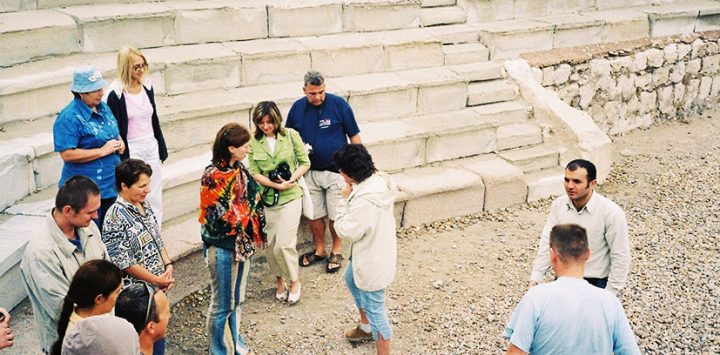Geographical Location of the Roman Amphitheater
The Roman Amphitheater is located in Alexandria in the Western section of the city in an area which was called Kom El Dikka or the pile of rubbles. This name goes back when the famous Alexandrian historian; El Newery visited this section of Alexandria in the middle of the 19th century and saw this high sand hill which looked like a desk, or a dikka in the Arabic language.
The traveler can easily reach the Roman Amphitheater by a taxi or even some public buses which go to this part of the city of Alexandria. However, it is always recommended for tourists, especially those spending their vacation in Egypt for the first time, to book a tour to Egypt with one of the reputable travel companies.
The Discovery and the History of the Roman Amphitheater
The Roman Amphitheater was discovered by mere coincidence! This was back in 1960 when the Egyptian government decided to remove the pile of rubbles or Kom El Dikka. Moreover, the government decided to construct a large building in that same location.
During the digging of the land in order to prepare for the cement and iron rods to go under the ground, one of these rods hit a solid object in the Eastern and the Southern section of the hill. This made the engineers sure that there were some architectural entity under the ground in that place.
Immediately afterwards, a Polish mission of archaeologists, representing the Antiquities of the Mediterranean Center, together with scientists from the Greco Roman Museum, representing the Egyptian Antiquities committee, started the excavation works. The results were quite astonishing as they were able to unearth one of the most remarkable Roman historical sites in Egypt which is now visited by large number of tours spending their holidays in Egypt.
The Roman Amphitheater was established in the 4th century AD and it was used until the 7th century AD. This was discovered by comparing the style of architecture, the materials used in the construction, and the design outlines of the Roman Amphitheater with other buildings established around the same period of time.
The scientific research has noted that the Roman Amphitheater has witnessed three eras; the Roman, the Coptic, and the Islamic period in Egypt and there were different usages for the theater in each of these eras.
The Description of the Roman Amphitheater
The Roman Amphitheater has the shape of the letter “U” or a horseshoe. An astonishing fact about the Roman Amphitheater is that it was never a theater! A comparison which was carried out between the Roman Amphitheater in Alexandria and other similar constructions in Italy, Greece, and Tunisia asserted the fact that the building in Alexandria was never intended to be a theater.
This is because theater in the Greco Roman period used to have the shape of the letter C or an unfinished circle to enable audiences sitting in the corners to view the performance. Moreover, the Roman Amphitheater is a small establishment in comparison to the large number of inhabitants who lived in Alexandria at the time confirmed the fact that it was never a theater.
The Roman Amphitheater consists of 13 rows of marble seats numbered using the Greek figures in order to regulate and facilitate the seating procedures of the audience. The first steps of the theater were made out of strong pink granite from inside in order to be the base for the rest of the rows.
At the top of these rows, there were five compartments that were used for sleeping and only two out of them survived until today. The ceilings of these compartments used to have domes which were based on strong columns. These domes were constructed to protect the audience from the sun and the rain. This is beside another role these domes played in transferring the sounds properly to these sections of the Roman Amphitheater. However, all these domes and columns collapsed due to the earthquake that hit Alexandria during the 6th century AD.
The rows of the Roman Amphitheater in Alexandria are based on a thick wall of limestone surrounded by another wall. Some arches and domes used to link these two walls together as the outer wall is considered a strong support for the inner wall. This was a common feature in the Roman architecture of this type of constructions at that period of time. A passageway between these two walls was constructed and the employees who worked in the Roman Amphitheater used it.
The section of the orchestra is situated in the middle of the marble steps and it is supported with two large marble columns. There are also two sections which are characterized with their magnificent mosaic floor that survived until today.
The Amphitheater had two entrances during the Roman period; one of them in the Southern section while the second was in the Northern section. However, these two entrances were closed during the Byzantine ruling period. There were also two large rooms in the Southern and the Northern entrances that were used as waiting rooms.
Away from the Roman Amphitheater, there are some interesting displays that go back to the Roman period in Egypt that are displayed near the theater. This includes a number of statues, some wonderfully ornamented stone capitals, and some other interesting exhibits. This is besides the Roman villa, or the Villa of the birds that was discovered lately and it is featured with wonderful mosaics which are dominated with birds’ shapes and drawings.
Today, one can never find any travel package in Alexandria that misses a visit to the Roman Amphitheater as part of the tour to Alexandria. Many travelers from various nationalities who visit Egypt love to explore monuments which belong to the Greco Roman period in the land of the Nile.













